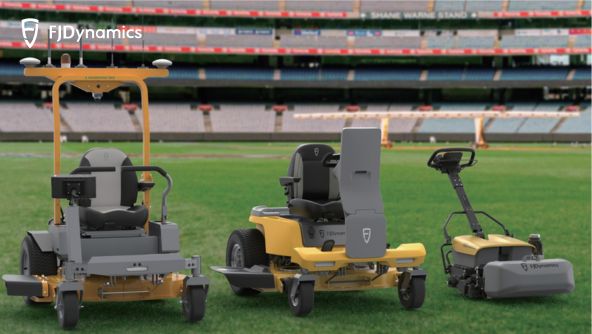
Title: Transforming Groundskeeping: The Impact of Cutting-Edge Technology on Field Maintenance
Facility managers and business leaders are increasingly adopting state-of-the-art technology to optimize groundskeeping operations and enhance efficiency. As innovations revolutionize maintenance approaches, the integration of high-performance equipment like robotic line marking tools is becoming essential for maintaining sports fields and expansive green areas with remarkable accuracy and minimized labor.
By decreasing manual tasks and improving scheduling accuracy, contemporary technology is reshaping the potentials in grounds maintenance. Let’s explore how these advancements are catalyzing change and what factors organizations must consider during this transition.
The Advancement of Field Maintenance Equipment
Historically, field maintenance has depended largely on manual work, necessitating extensive efforts to guarantee playability and visual appeal, particularly for sports fields. Marking a soccer pitch or maintaining turf quality could consume countless hours and require numerous staff members. However, the development of automated equipment has alleviated much of this burden.
Today, robotic instruments such as GPS-equipped line marking machines have transformed processes that were once laborious. Automation significantly cuts down the time needed to establish field layouts while ensuring precision that is often challenging for human operators to consistently achieve. These intelligent devices retain field designs, efficiently replicate measurements, and even adapt to individual field conditions.
This advancement is indicative of a larger trend in facility management — one in which digital solutions are not just supplementary but fundamental to strategic planning. This shift also aids in lowering labor costs, reducing human error, and promoting sustainability through more efficient material use.
Advantages of Adopting Advanced Machinery
For entrepreneurs and facility managers, the implementation of automated systems presents both immediate and enduring organizational advantages. The most notable benefits include:
1. Time Efficiency:
With robotic line markers capable of outlining an entire soccer field in less than 30 minutes, teams can refocus their time on turf care, staff coordination, and other high-priority responsibilities.
2. Accuracy and Consistency:
Automated systems eliminate uncertainty, ensuring lines are marked precisely to regulatory specifications. The likelihood of having to redo work is significantly lowered, resulting in fewer interruptions in operations.
3. Workforce Optimization:
These intelligent machines enable a single operator to oversee what used to require multiple team members. This allows facility teams to become more streamlined or reallocate staff to maintenance areas that benefit from human oversight.
4. Improved Visual Appeal:
Automated devices enhance the professional aesthetic of grounds by producing straight, uniform lines regardless of weather conditions or terrain characteristics — a crucial element in delivering an exceptional experience for players and audiences.
5. Financial Efficiency:
Although the initial cost of equipment may seem high, long-term savings are unavoidable. Reduced man-hours, less material wastage, and fewer operational hold-ups contribute to a tangible return on investment.
Streamlining Operations with Robotic Technologies
Beyond line marking, robotic innovations are being employed in various groundskeeping roles, including mowing, irrigation management, and soil analysis. These machines can be programmed for designated tasks at predetermined intervals, guaranteeing uniformity and maximizing productivity. For example:
– Robotic mowers manage consistent grass height while maneuvering around obstacles.
– Sensors linked to irrigation systems guarantee water is utilized only when and where necessary.
– Drones may perform quick visual evaluations of large sports complexes or parks.
Such integrated systems provide predictive maintenance capabilities by notifying personnel of issues before they escalate. Consequently, this predictive ability results in reduced downtime and improved field conditions year-round.
Implementing robotic solutions also sets the stage for data-driven decision-making. Facility managers can monitor performance indicators to continually enhance maintenance schedules, further increasing efficiency.
Key Considerations for Technology Integration
While the advantages are evident, effective adoption necessitates a careful strategy. The following aspects should be assessed when incorporating advanced tools into groundskeeping practices:
1. Site Requirements:
Different facilities have distinct needs based on field sizes, usage frequencies, and budget limitations. Ensure that the technology you select aligns with your site’s specific requirements.
2. User-Friendliness:
Intuitive interfaces and easy-to-use controls are crucial—especially when training current staff. Machines with training resources, mobile applications, and customer support are particularly beneficial during the implementation period.
3. Compatibility with Existing Infrastructure:
Verify that the new equipment functions well with current tools. Compatibility reduces redundancy and can enhance the lifespan of existing resources.
4. Training and Assistance:
Effectively training staff to utilize automated machinery requires an initial commitment to education. Purchasing equipment from suppliers that provide demonstrations, manuals, and post-purchase support ensures a smoother transition.
5. Flexibility and Future Updates:
Choose tools that are adaptable and capable of supporting future upgrades. A machine equipped with advanced software features, for example, can be updated remotely as new improvements become available, prolonging its usefulness.
Conclusion: Welcoming the Future of Groundskeeping
The integration of advanced machinery into groundskeeping operations signifies a union of tradition and innovation. Whether utilizing robotic line marking systems or fully integrated maintenance scheduling software, these technologies empower facilities to elevate their standards while reducing costs.
Entrepreneurs and facility managers who embrace these innovations early position themselves at the forefront of an increasingly competitive and quality-focused industry.